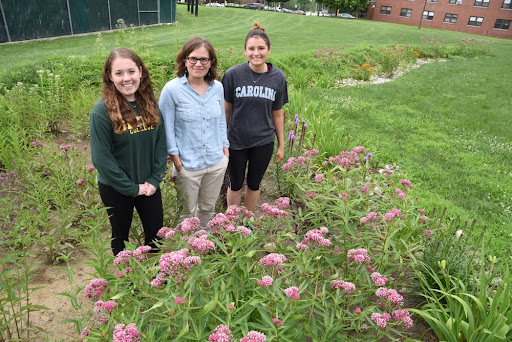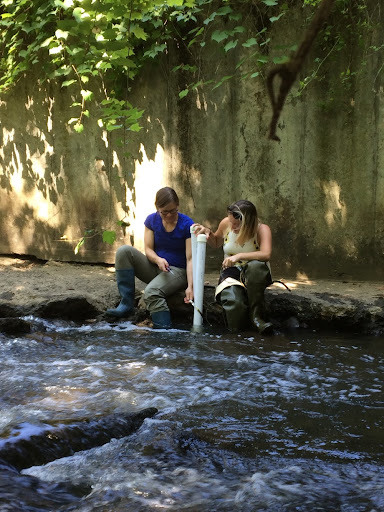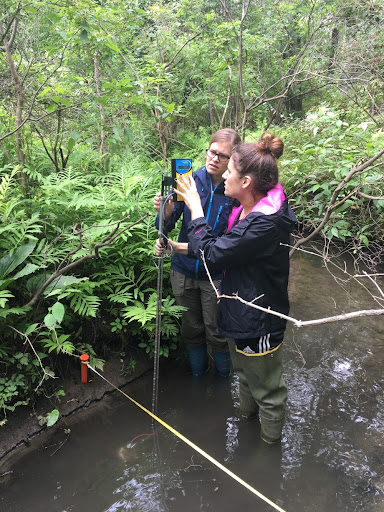For environmental scientist Katherine Meierdiercks, collaborating with communities is part of the job
You could say coming to Siena College as an assistant professor was a watershed moment for watershed expert Katherine Meierdiercks, PhD. Having long approached science as an expression of service, Meierdiercks found in the college the mix of encouragement, opportunities and support she needed to take those ideals and run with them, grounding her science teaching and research in community engagement.
Today, she continues to practice community-based research while bringing that same ethos to the next generation of students and faculty in her role as associate professor and chair of Siena’s Department of Environmental Studies and Sciences. We sat down with Meierdiercks for a conversation about her focus on teaching not just the how of science, but the why.
Valuing community connections

Meierdiercks with students in a Siena campus rain garden. The garden was designed by students and built by students with the help of Facilities staff.
As a Franciscan and Catholic institution, Siena College is rooted in the ideas of care for creation and service to the community. Service learning—in which students learn by applying their knowledge and skills to community issues—is integral to the college’s overall approach to education.
“Community collaboration is valued by the institution. It’s built into our mission statement. It’s actually built into my tenure and promotion guidelines,” says Meierdiercks.
While more research-oriented institutions focus on providing students deep knowledge in particular areas, small liberal arts institutions like Siena aim for breadth. Meierdiercks says community-based projects provide a rich ground for students to expand their horizons while putting knowledge into practice.
“Working with community groups gives a breadth of projects I wouldn’t have been able to invent on my own,” she says. “It also provides great networking opportunities—students get internships with community partners and gain important social skills, like teamwork.”
Engaging virtually, expanding reach
For many years, Meierdiercks and her students conducted field research and mapped watersheds around the upstate New York area, where she serves on the Board of the Hudson River Watershed Alliance. When a colleague forwarded her an announcement about a Thriving Earth project, Meierdiercks had been seeking to expand her community engagement work to a broader geographic area.

Installing monitoring equipment in a stream channel in Albany, New York.
“Siena not only values local and regional service, but wants their faculty to be national leaders in service learning and community-based research,” says Meierdiercks. Signing on as scientific partner with a Thriving Earth Exchange project in Ottawa County, Oklahoma—some 1,300 miles away—gave her an opportunity to immerse herself in a new set of issues and challenges, from both a scientific and community perspective.
The opportunity came at a good time, when videoconferencing has become a normal part of how we interact. “There have been so few positives of this pandemic, but one is that people feel so comfortable using Zoom,” says Meierdiercks. Still, even with the easy connectivity technology brings, she adds that it has been important to stay mindful of her position as an “outsider” and to recognize that the rural Oklahoma community she is working with might have a different cultural, political and social context from her own community in New York.
An appreciation for structure
Though Meierdiercks had led community-based research projects for more than a decade before joining the Thriving Earth project, she says working with a Thriving Earth Exchange Community Science Fellow has been extremely valuable. In addition to establishing a process and helping the team work through milestones, she appreciates how much work Fellow Jessica Tran put into vetting the project proposal and identifying the right set of partners during the project’s launch. Achieving such alignment can be challenging when trying to start projects through cold calls or conversations at conferences, especially when projects must be done within the course of a single semester, Meierdiercks says.
“I made a lot of mistakes early on when I started doing this work 12 years ago, and I’m still learning,” she says. “Thriving Earth Exchange is a great way to learn the model, and I think it would be especially useful for someone who hasn’t done a lot of community-based research. I also really appreciate the structure and accountability all the way through the project.”
Finding balance

Meierdiercks and a Siena student making direct discharge streamflow measurements in a campus stream channel.
While Meierdiercks finds community science and service-based learning to be professionally and personally rewarding, she says it’s crucial to recognize the amount of work it takes. Building trust, meeting regularly, and following up on projects are things that simply cannot be rushed—and diving in without being able to follow through on a commitment can damage relationships. As such, it’s important to be clear on what each party is offering to do, and when.
It’s also important to be upfront about why you are involved in the engagement. Wary of perpetuating a “white savior” approach to service learning, Meierdiercks strives to listen, learn, and understand, but also to make clear what she is giving to the project, and what she is getting out of it—such as grant funding, teaching tools or assets for her scholarship portfolio.
“Before I jump in, I try to be honest and transparent about the fact that I get benefits out of this, too,” she says. “I get personal satisfaction from knowing that my skills are useful to the community, and there can also be financial benefits and professional benefits. There can be mutual benefits, and it’s especially important for students to hear that.”
Learn more about serving as a scientific partner with Thriving Earth Exchange. Want more scientist stories? Read reflections from scientists working with communities on plastic pollution and flooding.
